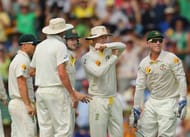Evolution is the truth of time. Time has made the whole mankind evolve. Technology, a gift of mankind, isn't left out from the evolution process.
From the invention of wheels to the present supercomputers and robots, the evolution of technology has been on an upward slope. Technology has just not evolved but has now become a necessity for the living.
Today, no area remains untouched from this gift of mankind and the field of sports is no different. Technology in sports has not only brought accuracy but has even played the role of monitoring it well. The convenience that technology has brought for the audience and players is amazing.
Not every technological up gradation in sports is important. Some are mere luxury whereas some form the support system. One among the very vital technologies introduced to the sport of cricket is the Third Umpire.
Third Umpire or the off-field umpire is one to whom such matters are referred, which the on-field umpires don't have an answer to like in case of run-outs, catches, stumpings or boundaries.
Third Umpire or TV umpire was conceptualized by a former Sri Lankan Test cricketer and a cricket writer, Mahinda Wijesinghe. It made its first appearance in a match between South Africa and India.
Karl Liebenberg was the third umpire. Sachin Tendulkar tops the charts here too. He became the first player to be adjudged out by the TV umpire when he was run out by Jonty Rhodes on the score of 11.
The functionality of third umpire is quite easy to understand. Firstly, we should remember that third umpires can be consulted only in cases involving run outs, catches, stumpings and boundaries. The decision of the third umpire can be understood only when one is well versed with the concepts of run outs, catches and so on.
A batsman is run out when he is out of his crease and the wicket is put down. For a wicket to be put down the bail should be removed or a wicket is struck out of the ground whether by the ball or by the hand of the striker with the ball in one hand and wicket in another. This is easy to say but tricky to decide for an onfield umpire.
So generally the on-field umpire consults the third umpire. The TV umpire, with the help of different angles and technical tools available to him, is able to reach a fair decision which is then communicated by him to the on-field umpire through a radio link. The dismissal through stumping also goes through the same path.
Sometimes the catch is taken where the fielder is very close to the boundary line or the catch has been taken inches above the ground. Such instances create doubt in the minds of umpires and even the batsman in question on how clean the catch is.
Then too, the umpire can consult the third umpire to facilitate a better decision making. The third umpire has access to instant replays of the incident in question to improve the process of better decision making in double quick time.
It is to be kept in mind that the Third Umpire should not be taken as a symbol of inability of the two field umpires to solve on field matters. He is just a supporting umpire who has access to different technological tools to come to the right conclusion.
The third umpire takes his time, analyses a pending matter from all angles and then gives his decision. The on-field umpires actually face the real music as they have to deliver decisions in a matter of seconds and that too with no technological help.
The concept of third umpire is in a way very ironical. Except the players and umpires involved in a particular match, all others can watch the match very closely. They can even notice the strong zones and weak zones of batsmen, ball tampering, etc. The irony doesn't end here. With the advent of third umpires, which is actually better than the two on-field umpires, the notion "Umpire's decision is final" has taken a major hit.
Even the third umpire has been under an evolution process in the last few years with the concept of DRS (Decision Reviewal System) coming onto the international arena. DRS is a rule through which if a player unsatisfied with the on-field umpire's decision can ask for its reviewal from the third umpire.
If the third umpire sees that the on-field decision is wrong, he can overturn it otherwise it stays the same. Although the concept and motive behind DRS seems pretty fair, the system has had its own share of mistakes. Some decisions in the recent past have gone horribly wrong even after the use of DRS. This has created doubts in the minds of players and spectators over the credibility of this newly introduced advancement. All in all, the longevity of DRS is a topic under consideration.
A high stake sport needs a greater accuracy in decisions. The advent of televisions and slow motion replays really undermined the authority of umpires. Hence, the need of third umpires in this high growth era is greater than ever. Even though the system is fault free, a helpful advancement in the current system, if found, is of no harm.
Looking for fast live cricket scores? Download CricRocket and get fast score updates, top-notch commentary in-depth match stats & much more! 🚀☄️


